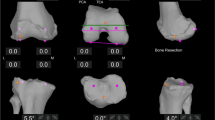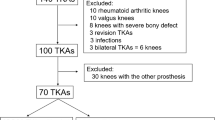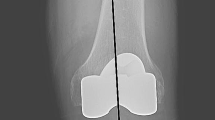Abstract
Purpose
An anatomo-functional implant positioning (AFIP) technique in total knee arthroplasty (TKA) could restore physiological ligament balance (symmetric gap in extension, asymmetric gap in flexion). The purposes were to compare (1) ligament balancing in extension and flexion after TKA in the AFIP group, (2) TKA alignment, implant positioning and patellar tracking between AFIP and adjusted mechanical alignment (aMA) techniques, (3) clinical outcomes between both groups at 12 months.
Methods
All robotic-assisted TKA with an AFIP technique were included (n = 40). Exclusion criteria were genu valgum (HKA angle > 183°), extra-articular deformity more than 10°, and patellar maltracking (high-grade J-sign). One control patient with a TKA implanted by an aMA technique was matched for each case, based on age, body mass index, sex, and knee alignment. Ligament balancing (medial and lateral gaps in millimeters) in full extension and at 90° of flexion after TKA in the AFIP group was assessed with the robotic system. TKA alignment (HKA angle), implants positioning (femoral and tibial coronal axis, tibial slope, joint-line orientation), patellar tracking (patellar tilt and translation) and the Knee Society Score (KSS) at 6 and 12 months were compared between both groups. The ligament balancing was compared using a t test for paired samples in the AFIP group. The radiographic measurements and KSS scores were compared between groups using a t test for independent samples.
Results
In the AFIP group, there was no significant difference between the medial and lateral gap laxity in extension (NS). A significant opening of the lateral gap was observed in flexion compared to extension (mean: + 2.9 mm; p < 0.0001). The mean postoperative HKA angle was comparable between both groups (177.3° ± 2.1 in the AFIP group vs 176.8° ± 3.2; NS). In the AFIP group, the femoral anatomy was restored (90.9° ± 1.6) and the tibial varus was partially corrected (87.4° ± 1.8). The improvement of Knee and Function KSS at 6 months was better in the AFIP group (59.3 ± 11.9 and 51.7 ± 20, respectively, versus 49.3 ± 9.7 and 20.8 ± 13; p < 0.001).
Conclusion
The AFIP concept allowed the restoration of the native knee alignment and a natural functional ligament pattern. With a more physiological target for ligament balancing, the AFIP technique had equivalent clinical outcomes at 12 months compared to aMA, with a faster recovery.
Level of evidence
III retrospective therapeutic case control series.





Similar content being viewed by others
Abbreviations
- AFIP:
-
Anatomo-functional implant positioning
- BMI:
-
Body mass index
- HKA:
-
Hip–knee angle
- JLCA:
-
Joint-line convergence angle
- JLO:
-
Joint-line orientation
- KA:
-
Kinematic alignment
- KSS:
-
Knee Society Score
- MA:
-
Mechanical alignment
- MCL:
-
Medial collateral ligament
- mMDFA:
-
Mechanical medial distal femoral angle
- MPTA:
-
Medial proximal tibial angle
- PA:
-
Personalized alignment
- raTKA:
-
Robotic-assisted total knee arthroplasty
- ROM:
-
Range of motion
- TKA:
-
Total knee arthroplasty
References
Almaawi AM, Hutt JRB, Masse V, Lavigne M, Vendittoli PA (2017) The impact of mechanical and restricted kinematic alignment on knee anatomy in total knee arthroplasty. J Arthroplasty 32:2133–2140
Anglin C, Brimacombe JM, Hodgson AJ, Masri BA, Greidanus NV, Tonetti J et al (2008) Determinants of patellar tracking in total knee arthroplasty. Clin Biomech (Bristol, Avon) 23:900–910
Argenson JN, Parratte S, Ashour A, Komistek RD, Scuderi GR (2008) Patient-reported outcome correlates with knee function after a single-design mobile-bearing TKA. Clin Orthop Relat Res 466:2669–2676
Bach CM, Nogler M, Steingruber IE, Ogon M, Wimmer C, Gobel G et al (2002) Scoring systems in total knee arthroplasty. Clin Orthop Relat Res 399:184–196
Batailler C, Hannouche D, Benazzo F, Parratte S (2021) Concepts and techniques of a new robotically assisted technique for total knee arthroplasty: the ROSA knee system. Arch Orthop Trauma Surg 141:2049–2058
Bellemans J, Banks S, Victor J, Vandenneucker H, Moemans A (2002) Fluoroscopic analysis of the kinematics of deep flexion in total knee arthroplasty. Influence of posterior condylar offset. J Bone Joint Surg Br 84:50–53
Bellemans J, Colyn W, Vandenneucker H, Victor J (2012) The Chitranjan Ranawat award: is neutral mechanical alignment normal for all patients? The concept of constitutional varus. Clin Orthop Relat Res 470:45–53
Blaha JD, Mancinelli CA, Simons WH, Kish VL, Thyagarajan G (2003) Kinematics of the human knee using an open chain cadaver model. Clin Orthop Relat Res 410:25–34
Blakeney W, Clement J, Desmeules F, Hagemeister N, Riviere C, Vendittoli PA (2019) Kinematic alignment in total knee arthroplasty better reproduces normal gait than mechanical alignment. Knee Surg Sports Traumatol Arthrosc 27:1410–1417
Brar AS, Howell SM, Hull ML, Mahfouz MR (2016) Does Kinematic Alignment and flexion of a femoral component designed for mechanical alignment reduce the proximal and lateral reach of the trochlea? J Arthroplasty 31:1808–1813
de Boer JJ, Blankevoort L, Kingma I, Vorster W (2009) In vitro study of inter-individual variation in posterior slope in the knee joint. Clin Biomech (Bristol, Avon) 24:488–492
Dossett HG, Estrada NA, Swartz GJ, LeFevre GW, Kwasman BG (2014) A randomised controlled trial of kinematically and mechanically aligned total knee replacements: two-year clinical results. Bone Joint J 96B:907–913
Ferle M, Guo R, Hurschler C (2019) The laxity of the native knee: a meta-analysis of in vitro studies. J Bone Joint Surg Am 101:1119–1131
Franciozi CE, Ambra LF, Albertoni LJB, Debieux P, Granata GSM Jr, Kubota MS et al (2019) Anteromedial tibial tubercle osteotomy improves results of medial patellofemoral ligament reconstruction for recurrent patellar instability in patients with tibial tuberosity-trochlear groove distance of 17 to 20 mm. Arthroscopy 35:566–574
Gharaibeh MA, Monk E, Chen DB, MacDessi SJ (2018) Evaluation of the patellofemoral joint in total knee arthroplasty: validation of the weight bearing merchant radiographic view. Knee 25:1262–1271
Goh GS, Liow MHL, Chen JY, Tay DK, Lo NN, Yeo SJ (2021) The patient acceptable symptom state for the Knee Society Score, Oxford Knee Score and Short Form-36 following unicompartmental knee arthroplasty. Knee Surg Sports Traumatol Arthrosc. https://doi.org/10.1007/s00167-021-06592-x
Graichen H, Lekkreusuwan K, Eller K, Grau T, Hirschmann MT, Scior W (2021) A single type of varus knee does not exist: morphotyping and gap analysis in varus OA. Knee Surg Sports Traumatol Arthrosc. https://doi.org/10.1007/s00167-021-06688-4
Hill PF, Vedi V, Williams A, Iwaki H, Pinskerova V, Freeman MA (2000) Tibiofemoral movement 2: the loaded and unloaded living knee studied by MRI. J Bone Joint Surg Br 82:1196–1198
Hirschmann MT, Moser LB, Amsler F, Behrend H, Leclerq V, Hess S (2019) Functional knee phenotypes: a novel classification for phenotyping the coronal lower limb alignment based on the native alignment in young non-osteoarthritic patients. Knee Surg Sports Traumatol Arthrosc 27:1394–1402
Howell SM, Howell SJ, Kuznik KT, Cohen J, Hull ML (2013) Does a kinematically aligned total knee arthroplasty restore function without failure regardless of alignment category? Clin Orthop Relat Res 471:1000–1007
Howell SM, Papadopoulos S, Kuznik KT, Hull ML (2013) Accurate alignment and high function after kinematically aligned TKA performed with generic instruments. Knee Surg Sports Traumatol Arthrosc 21:2271–2280
Iwaki H, Pinskerova V, Freeman MA (2000) Tibiofemoral movement 1: the shapes and relative movements of the femur and tibia in the unloaded cadaver knee. J Bone Joint Surg Br 82:1189–1195
Kayani B, Konan S, Ayuob A, Onochie E, Al-Jabri T, Haddad FS (2019) Robotic technology in total knee arthroplasty: a systematic review. EFORT Open Rev 4:611–617
Kayani B, Konan S, Pietrzak JRT, Haddad FS (2018) Iatrogenic bone and soft tissue trauma in robotic-arm assisted total knee arthroplasty compared with conventional jig-based total knee arthroplasty: a prospective cohort study and validation of a new classification system. J Arthroplasty 33:2496–2501
Kayani B, Konan S, Tahmassebi J, Pietrzak JRT, Haddad FS (2018) Robotic-arm assisted total knee arthroplasty is associated with improved early functional recovery and reduced time to hospital discharge compared with conventional jig-based total knee arthroplasty: a prospective cohort study. Bone Joint J 100-B:930–937
Koh DTS, Woo YL, Yew AKS, Yeo SJ (2021) Kinematic aligned femoral rotation leads to greater patella tilt but similar clinical outcomes when compared to traditional femoral component rotation in total knee arthroplasty. A propensity score matched study. Knee Surg Sports Traumatol Arthrosc 29:1059–1066
Liu F, Gadikota HR, Kozanek M, Hosseini A, Yue B, Gill TJ et al (2011) In vivo length patterns of the medial collateral ligament during the stance phase of gait. Knee Surg Sports Traumatol Arthrosc 19:719–727
Lizaur-Utrilla A, Gonzalez-Parreno S, Martinez-Mendez D, Miralles-Munoz FA, Lopez-Prats FA (2020) Minimal clinically important differences and substantial clinical benefits for Knee Society Scores. Knee Surg Sports Traumatol Arthrosc 28:1473–1478
Lozano R, Campanelli V, Howell S, Hull M (2019) Kinematic alignment more closely restores the groove location and the sulcus angle of the native trochlea than mechanical alignment: implications for prosthetic design. Knee Surg Sports Traumatol Arthrosc 27:1504–1513
MacDessi SJ, Griffiths-Jones W, Chen DB, Griffiths-Jones S, Wood JA, Diwan AD et al (2020) Restoring the constitutional alignment with a restrictive kinematic protocol improves quantitative soft-tissue balance in total knee arthroplasty: a randomized controlled trial. Bone Joint J 102-B:117–124
MacDessi SJ, Griffiths-Jones W, Harris IA, Bellemans J, Chen DB (2021) Coronal Plane Alignment of the Knee (CPAK) classification. Bone Joint J 103-B:329–337
Marchand RC, Sodhi N, Khlopas A, Sultan AA, Harwin SF, Malkani AL et al (2017) Patient satisfaction outcomes after robotic arm-assisted total knee arthroplasty: a short-term evaluation. J Knee Surg 30:849–853
Mathijssen NMC, Verburg H, London NJ, Landsiedl M, Dominkus M (2019) Patient reported outcomes and implant survivorship after Total knee arthroplasty with the persona knee implant system: two year follow up. BMC Musculoskelet Disord 20:97
McEwen P, Balendra G, Doma K (2019) Medial and lateral gap laxity differential in computer-assisted kinematic total knee arthroplasty. Bone Joint J 101-B:331–339
McEwen PJ, Dlaska CE, Jovanovic IA, Doma K, Brandon BJ (2020) Computer-assisted kinematic and mechanical axis total knee arthroplasty: a prospective randomized controlled trial of bilateral simultaneous surgery. J Arthroplasty 35:443–450
Mohanty SS, Rao NN, Dash KK, Bhosale SK (2013) Correlation of posterior tibial slope with metaphysio-diaphyseal angle in total knee arthroplasty: a radiological study. Indian J Orthop 47:67–71
Nakamura S, Tian Y, Tanaka Y, Kuriyama S, Ito H, Furu M et al (2017) The effects of kinematically aligned total knee arthroplasty on stress at the medial tibia: a case study for varus knee. Bone Joint Res 6:43–51
Nedopil AJ, Singh AK, Howell SM, Hull ML (2018) Does calipered kinematically aligned TKA restore native left to right symmetry of the lower limb and improve function? J Arthroplasty 33:398–406
Norman GR, Sloan JA, Wyrwich KW (2004) The truly remarkable universality of half a standard deviation: confirmation through another look. Expert Rev Pharmacoecon Outcomes Res 4:581–585
Okazaki K, Miura H, Matsuda S, Takeuchi N, Mawatari T, Hashizume M et al (2006) Asymmetry of mediolateral laxity of the normal knee. J Orthop Sci 11:264–266
Parratte S, Price AJ, Jeys LM, Jackson WF, Clarke HD (2019) Accuracy of a new robotically assisted technique for total knee arthroplasty: a cadaveric study. J Arthroplasty 34:2799–2803
Piuzzi NS, Cleveland Clinic OMEAG (2021) Patient-reported outcomes at 1 and 2 years after total hip and knee arthroplasty: what is the minimum required follow-up? Arch Orthop Trauma Surg. https://doi.org/10.1007/s00402-021-03819-x
Regier DA, Narrow WE, Clarke DE, Kraemer HC, Kuramoto SJ, Kuhl EA et al (2013) DSM-5 field trials in the United States and Canada, Part II: test-retest reliability of selected categorical diagnoses. Am J Psychiatry 170:59–70
Ritter MA, Faris PM, Keating EM, Meding JB (1994) Postoperative alignment of total knee replacement. Its effect on survival. Clin Orthop Relat Res 299:153–156
Riviere C, Iranpour F, Auvinet E, Aframian A, Asare K, Harris S et al (2017) Mechanical alignment technique for TKA: are there intrinsic technical limitations? Orthop Traumatol Surg Res 103:1057–1067
Riviere C, Iranpour F, Harris S, Auvinet E, Aframian A, Parratte S et al (2018) Differences in trochlear parameters between native and prosthetic kinematically or mechanically aligned knees. Orthop Traumatol Surg Res 104:165–170
Roth JD, Howell SM, Hull ML (2015) Native knee laxities at 0 degrees, 45 degrees, and 90 degrees of flexion and their relationship to the goal of the gap-balancing alignment method of total knee arthroplasty. J Bone Joint Surg Am 97:1678–1684
Seetharam A, Deckard ER, Ziemba-Davis M, Meneghini RM (2022) The AAHKS clinical research award: are minimum two-year patient-reported outcome measures necessary for accurate assessment of patient outcomes after primary total knee arthroplasty? J Arthroplasty. https://doi.org/10.1016/j.arth.2022.02.016
Smith AF, Eccles CJ, Bhimani SJ, Denehy KM, Bhimani RB, Smith LS et al (2019) Improved patient satisfaction following robotic-assisted total knee arthroplasty. J Knee Surg. https://doi.org/10.1055/s-0039-1700837
Victor JM, Bassens D, Bellemans J, Gursu S, Dhollander AA, Verdonk PC (2014) Constitutional varus does not affect joint line orientation in the coronal plane. Clin Orthop Relat Res 472:98–104
Al W, Qasim SS, Alsalman M (2020) Variability of the posterior tibial slope in saudis: a radiographic study. Cureus 12:e10699
Walker PS (2015) The design and pre-clinical evaluation of knee replacements for osteoarthritis. J Biomech 48:742–749
Winnock de Grave P, Luyckx T, Claeys K, Tampere T, Kellens J, Muller J et al (2020) Higher satisfaction after total knee arthroplasty using restricted inverse kinematic alignment compared to adjusted mechanical alignment. Knee Surg Sports Traumatol Arthrosc. https://doi.org/10.1007/s00167-020-06165-4
Yeo JH, Seon JK, Lee DH, Song EK (2019) No difference in outcomes and gait analysis between mechanical and kinematic knee alignment methods using robotic total knee arthroplasty. Knee Surg Sports Traumatol Arthrosc 27:1142–1147
Funding
This research did not receive any specific grant from funding agencies from the public, commercial, or not-for-profit sectors.
Author information
Authors and Affiliations
Contributions
SP: Study design, operator, manuscript editing and supervisor. PVO: Literature review and manuscript editing. MB: Literature review and manuscript editing. BYO: Study design, data collection and manuscript editing. CB: Study design, data collection, statistical analysis, literature review and manuscript writing.
Corresponding author
Ethics declarations
Conflict of interest
SP: Royalties from Zimmer Biomet and Newclip; Consultant for Zimmer Biomet; Treasurer for European Knee Society. PVO: Consultant for Microport; Shareholder for MoveUP. MB: Employee from Zimmer Biomet. BYO: Consultant for Smith and Nephew. CB: Grant from SoFCOT (Société francaise de chirurgie orthopédique et traumatologique).
Ethical approval
All procedures were performed in accordance with the ethical standards of the institutional and/or national research committee, the 1964 Helsinki declaration, and its later amendments, or comparable ethical standards. The approval from the internal review board was obtained (study ID Number: MF3867, approval date: 20th December 2020).
Informed consent
All patient participants provided informed consent for review of their medical records.
Additional information
Publisher's Note
Springer Nature remains neutral with regard to jurisdictional claims in published maps and institutional affiliations.
Rights and permissions
About this article
Cite this article
Parratte, S., Van Overschelde, P., Bandi, M. et al. An anatomo-functional implant positioning technique with robotic assistance for primary TKA allows the restoration of the native knee alignment and a natural functional ligament pattern, with a faster recovery at 6 months compared to an adjusted mechanical technique. Knee Surg Sports Traumatol Arthrosc 31, 1334–1346 (2023). https://doi.org/10.1007/s00167-022-06995-4
Received:
Accepted:
Published:
Issue Date:
DOI: https://doi.org/10.1007/s00167-022-06995-4




